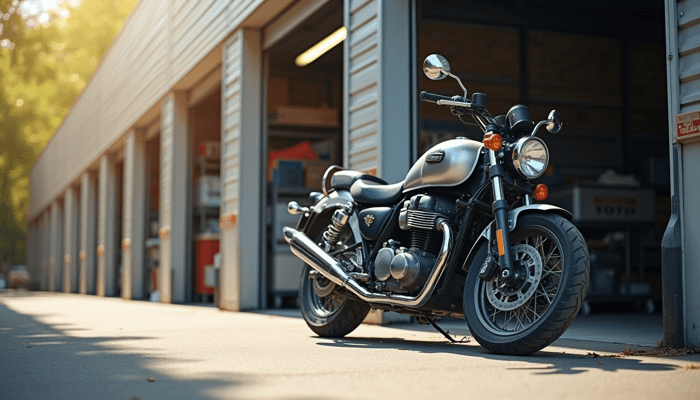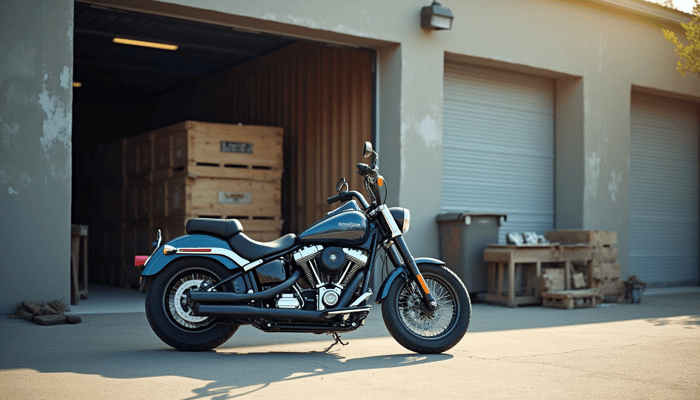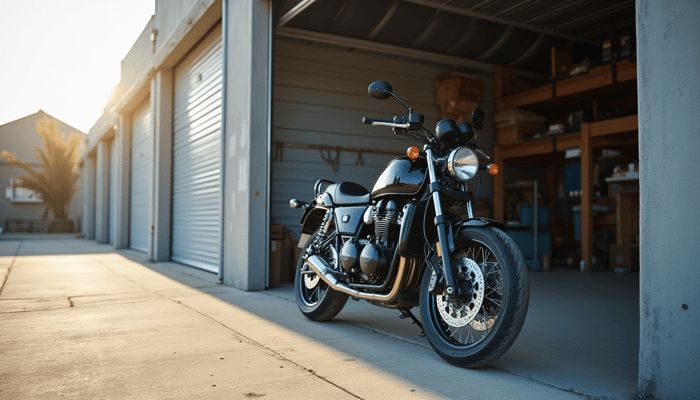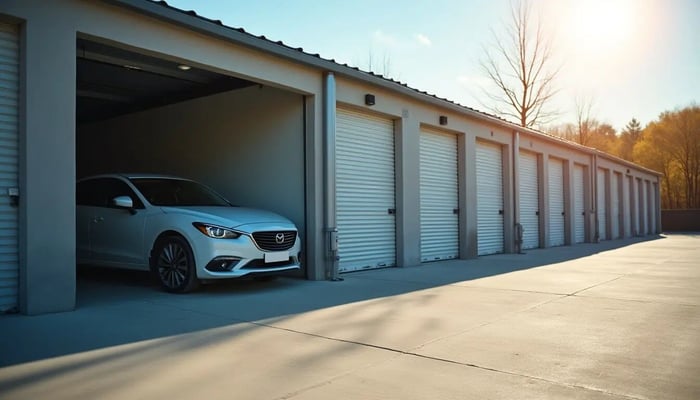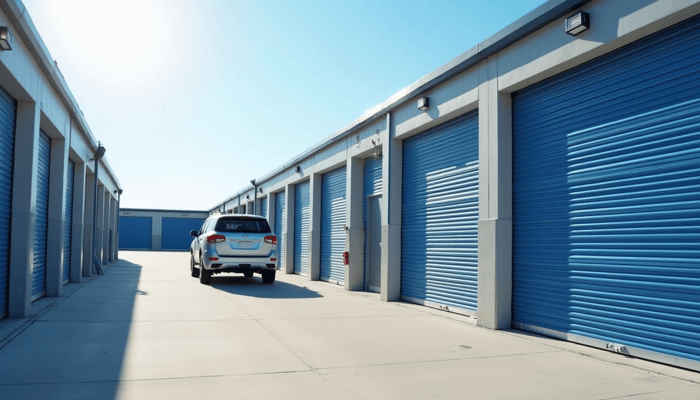Table of Contents
- Why Proper Motorcycle Storage Matters
- How Long Can You Store a Motorcycle Without Riding It?
- How Do Climate and Environment Affect Motorcycle Storage?
- Step-by-Step: How to Prepare a Motorcycle for Storage
- Is It Better to Store a Motorcycle Indoors or Outdoors?
- What Should You Check During Motorcycle Storage?
- How Do You Safely Take a Motorcycle Out of Storage?
- Troubleshooting Common Motorcycle Storage Issues
- Time to Rent a Motorcycle Storage Unit
- FAQs
Bikers everywhere know that proper motorcycle storage is more than rolling it into the garage and tossing a cover over it. Whether you’re parking your bike for a few weeks during bad weather or need motorcycle winter storage off-season, the proper preparation ensures it stays safe, protected, and ready to ride.
This guide covers everything you need to know: why storage prep matters, how to prepare your bike step-by-step, where to store it, what to check during downtime, and how to bring it back to life when riding season arrives.
Why Proper Motorcycle Storage Matters
Think of motorcycle storage as insurance for your investment. You want to keep your bike in excellent condition, and failing to prepare it can lead to:
Rust on exposed metal and inside the fuel tank
Dried-out seals and gaskets
Corroded electrical connections
Dead batteries that won’t recharge
Pests chewing through wiring or nesting inside exhaust pipes
All of this translates to costly repairs and frustration when you’re finally ready to ride. A little preventive care now ensures good condition and protects performance, resale value, and longevity.
How storage prevents a rough start next season
Nothing kills the excitement of spring like a dead battery, flat-spotted tires, or clogged fuel injectors. Proper storage guarantees that when you turn the key, your motorcycle fires up and runs smoothly.
At the end of the day, good storage prep equals peace of mind and a hassle-free first ride of the season.
How Long Can You Store a Motorcycle Without Riding It?
Before grabbing a wrench, identify how long your bike will be out of commission.
Short-term storage (1–2 months): Common for vacations or stretches of bad weather. Focus on fuel freshness and battery care.
Long-term storage (2+ months up to a year): Typical for winter or deployments. Requires comprehensive prep: fuel stabilizer, oil change, battery removal or tender, tire care, and pest prevention.
How Do Climate and Environment Affect Motorcycle Storage?
Where and how you store your motorcycle is just as important as the length of time. Environmental conditions can dramatically impact your bike:
Humidity: Promotes rust and mold.
Temperature swings: Create condensation inside gas tanks and engines.
Dust: Accumulates on paint, chrome, and controls.
Rodents/insects: Attracted to dark, quiet spaces.
Tip: If you’re considering off-site storage, look for a drive-up or climate-controlled self-storage unit designed to protect vehicles.
Step-by-Step: How to Prepare a Motorcycle for Storage
Are you unsure about how to winterize or store your motorcycle? Follow this comprehensive checklist so that your bike is ready for downtime.
1. Clean and Protect Surfaces
Check your tire pressure.
Wash away grime, dirt, salt, and bugs. Do not store a dirty bike.
Dry thoroughly (a leaf blower helps in crevices).
Apply wax or polish on paint and chrome for a protective barrier.
Condition leather or vinyl seats to prevent cracking.
2. Stabilize Your Fuel
Fill the tank with fresh gasoline to minimize air and condensation.
Add fuel stabilizer (STA-BIL, Sea Foam, etc.) and run the engine 5–10 minutes to circulate it.
Avoid draining fuel — modern stabilizers keep gas fresh, while draining exposes metal to rust.
3. Care for the Motorcycle Battery
Short-term: Leave connected to a smart battery tender/maintainer.
Long-term: Remove the battery, clean terminals, apply dielectric grease, and store in a cool, dry place.
Avoid old-style trickle chargers. They can overcharge and damage the battery.
4. Change the Oil & Filter
Old oil contains contaminants that corrode engine internals.
Replace oil and filter just before storage.
Run the engine briefly to circulate clean oil through the system.
5. Protect the Motorcycle Tires
Inflate to max PSI listed on sidewall.
Ideally, lift the bike with a motorcycle stand to take weight off the tires.
If not lifted, roll it a few inches monthly to prevent flat spots.
6. Guard the Engine & Exhaust (long-term only)
Spray fogging oil into cylinders via spark plugs to coat cylinder walls.
Plug exhaust outlets with steel wool or oily rags to block pests (remember to remove before riding!).
7. Lubricate Moving Parts
Lube throttle, clutch, and brake cables.
Grease pivot points (levers, footpegs, sidestand).
Clean and lubricate the drive chain.
8. Cover the Bike
Indoors: Use a breathable, soft motorcycle cover.
Outdoors: Use a heavy-duty, waterproof, UV-resistant cover with vents. Avoid plastic tarps — they trap moisture.
A Pro-Tip? Always cross-reference these tips with your motorcycle’s owner’s manual storage guidelines. The manufacturer will provide additional tips on topics such as preventing corrosion, applying a clear coat to motorcycle chrome, and whether a fuel stabilizer additive is necessary.
Is It Better to Store a Motorcycle Indoors or Outdoors?
Motorcycles endure a lot on the road, but they’re still vulnerable when parked. Indoor storage is always best.
Best Indoor Options
Garage: Convenient and protective, but monitor humidity. Sufficient during cold weather.
Shed: Works if secure, dry, and ventilated.
Climate-controlled storage unit: The gold standard. Stable temperature/humidity, secure, and rodent-resistant. Great options for storage during the winter months.
Outdoor Storage (Last Resort)
Pick a sheltered spot (carport, awning, side yard).
Place plywood or a tarp under tires to block ground moisture.
Use heavy security: ground anchor, chains, disc lock, alarm.
Double up on high-quality outdoor covers.
Indoors is ideal. If outdoors is your only option, invest in security and weather protection. Also, you can find a self-storage facility near you and rent an indoor storage unit.
What Should You Check During Motorcycle Storage?
Even if your motorcycle is in hibernation, it’s not “set and forget.” A quick monthly inspection prevents spring surprises.
Battery: Check voltage if not on a maintainer. Recharge if under 12.5V.
Tires: Check pressure monthly; reinflate as needed.
Fluids: Verify coolant, brake fluid, and oil levels.
Controls: Test clutch, brake levers, and throttle feel.
Pests: Inspect for droppings, nests, or chewed wires.
General check: Look for leaks, rust, or cover damage.
A good rule of thumb is to spend 5 minutes a month checking your bike. It will save 5 hours of repair time in the future.
How Do You Safely Take a Motorcycle Out of Storage?
When riding season returns, don’t just twist the throttle and go. Follow this restart checklist:
Pre-Ride Checklist
Remove exhaust plugs or coverings.
Check all fluid levels (oil, brake, coolant).
Inspect and test brakes.
Inflate tires to riding PSI.
Reinstall or disconnect the battery tender.
Verify lights, horn, and controls.
Inspect the chain, cables, and for leaks/pest damage.
First Startup Tips
Turn the key on and let the fuel pump prime.
Use choke if applicable, but avoid excessive throttle.
Let engine idle and fully warm before riding.
Take a short, gentle ride to confirm everything feels right.
Troubleshooting Common Motorcycle Storage Issues
Even with prep, some issues may appear after storage.
Dead battery: Use a battery charger or replace it if it won’t hold a charge.
Flat-spotted tires: Inflate and ride gently; replace if severe.
Fuel system issues: Stale gas can gum up injectors or carbs. Drain old fuel, add fresh with cleaner, or have the system professionally serviced.
Rusty chain or controls: Clean and lubricate before riding.
Time to Rent a Motorcycle Storage Unit
If you’re ready to protect your ride during winter or extended downtime, Storage Star makes it easy. We offer a range of self-storage options:
Small units (5x10, 5x15): Great for standard motorcycles, dirt bikes, Harley-Davidsons, and cruisers
Medium units (10x10): Perfect for touring bikes and motorcycles with trailers
With flexible month-to-month leases, climate-controlled options, and easy online reservations, Storage Star helps you keep your bike in road-ready condition year-round. Whether you’re storing your bike for an extended period of time or plan to take it out for winter riding, we have motorcycle storage options for everyone.
Find a Storage Star facility near you and reserve your motorcycle storage unit today! If you need more motorcycle storage tips, contact us today!
FAQs
Is it okay to start my motorcycle periodically during long-term storage?
Generally, no. Running the engine for just a few minutes without letting it reach full operating temperature can cause condensation in the engine and exhaust system. This moisture won’t evaporate, and fresh oil won’t fully circulate, which can actually increase wear and corrosion.
❌ Avoid short engine starts during storage
✅ Instead, prepare it properly once and leave it until riding season
Skip periodic starts. Proper storage prep protects your motorcycle better than occasional idling.
Do I need to remove my battery for short-term storage (1–2 months)?
For short-term storage, using a smart battery tender/maintainer is usually enough. Removal isn’t strictly necessary unless you prefer to disconnect it for peace of mind. For longer storage (3+ months), battery removal may be a safer option.
✅ Use a smart battery maintainer (aka battery tender)
❌ No need to remove for 1–2 months unless you want to
Keep your battery connected to a tender for short storage; consider removal only for extended downtime.
Can I use car fuel stabilizer for my motorcycle?
Yes! Most gasoline stabilizers (like STA-BIL or Sea Foam) work for both cars and motorcycles. Just make sure to follow the dosage instructions for your motorcycle’s smaller tank capacity.
✅ Fuel stabilizers are cross-compatible
⚠️ Always measure for motorcycle tank size
You can safely use car fuel stabilizer in a motorcycle — just adjust the dosage correctly.
What’s the biggest mistake people make when storing a motorcycle?
The most damaging mistake is neglecting the fuel system. Leaving untreated fuel to go stale can clog carburetors and injectors, leading to costly repairs.
❌ Don’t leave untreated gas in the tank
✅ Always add stabilizer and run it through the system before storage
Treat your fuel system before storage. It’s the #1 way to avoid expensive springtime repairs.
How often should I check my motorcycle during long-term storage?
A quick check once a month is ideal. This lets you monitor the battery charge, tire pressure, and look for signs of pests or leaks before they become serious issues.
✅ Monthly walk-around inspection
✅ Verify battery, tires, and no rodent/pest damage
A simple monthly checkup keeps small storage issues from turning into big headaches.
Should I drain the fuel entirely for long-term storage?
Not anymore. While older recommendations suggested draining, modern best practice is to fill the tank with fresh gasoline plus a stabilizer. Draining can leave metal exposed, leading to rust and dried-out seals.
✅ Fill the tank and add stabilizer
❌ Avoid draining — it can cause corrosion and seal damage
Keep your fuel system full and stabilized. It is safer than draining and preserves your motorcycle better.
